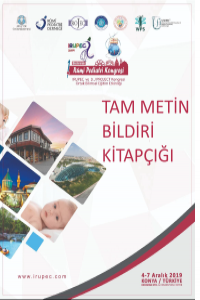Conference Paper
Year 2019,
Volume: 7 Issue: Ek - IRUPEC 2019 Kongresi Tam Metin Bildirileri, 1 - 4, 10.12.2019
Abstract
Bruxism related to sleep involves activation of the chewing muscles and results in tooth clenching, chattering, and grinding. Risk factors related to bruxism in sleep are obstructive sleep apnea, alcohol, caffeine, parasomnias such as sleep-talking and sleepwalking, anxiety, and other psychiatric and neurologic disorders, and some medications. There is still no treatment proven to be effective for the treatment of sleep bruxism. This case presents three school-aged children who presented with bruxism who responded to low-dose melaton
References
- Referanslar 1. American Academy of Sleep Medicine (2005). Diagnostic and Coding Manual 51-55. 2. Guaita M, Hogl B. Current Treatments of Bruxism. Curr Treat Options Neurol. 2016;18(2):10. 3. Lobbezoo F, van der Zaag J, van Selms MK, et al. Principles for the management of bruxism. J Oral Rehabil. 2008;35(7):509-23. 4. Shulman J. Teaching patients how to stop bruxing habits. J Am Dent Assoc. 2001;132(9):1275-7. 5. Jadidi F, Castrillon E, Svensson P. Effect of conditioning electrical stimuli on temporalis electromyographic activity during sleep. J Oral Rehabil. 2008;35(3):171-83. 6. Ommerborn MA, Schneider C, Giraki M, et al. Effects of an occlusal splint compared with cognitive-behavioral treatment on sleep bruxism activity. Eur J Oral Sci. 2007;115(1):7-14. 7. Falisi G, Rastelli C, Panti F, et al. Psychotropic drugs and bruxism. Expert Opin Drug Saf. 2014;13(10):1319-26. 8. Milosevic A, Agrawal N, Redfearn P, et al. The occurrence of toothwear in users of Ecstasy (3,4-methylenedioxymethamphetamine). Community Dent Oral Epidemiol. 1999;27(4):283-7. 9. Uca AU, Uguz F, Kozak HH, et al. Antidepressant-Induced Sleep Bruxism: Prevalence, Incidence, and Related Factors. Clin Neuropharmacol. 2015;38(6):227-30. 10. Lavigne GJ, Huynh N, Kato T, et al. Genesis of sleep bruxism: motor and autonomic-cardiac interactions. 2007;52(4):381-4. 11. Saletu A, Parapatics S, Anderer P, et al. Controlled clinical, polysomnographic and psychometric studies on differences between sleep bruxers and controls and acute effects of clonazepam as compared with placebo. Eur Arch Psychiatry Clin Neurosci. 2010;260(2):163-74. 12. Bostwick JM, Jaffee MS. Buspirone as an antidote to SSRI-induced bruxism in 4 cases. J Clin Psychiatry. 1999;60(12):857-60. 13. Albayrak Y, Ekinci O. Duloxetine-induced nocturnal bruxism resolved by buspirone: case report. Clin Neuropharmacol. 2011;34(4):137-8. 14. Boeve BF, Silber MH, Ferman TJ. Melatonin for treatment of REM sleep behavior disorder in neurologic disorders: results in 14 patients. Sleep Med. 2003;4(4):281-4.
Year 2019,
Volume: 7 Issue: Ek - IRUPEC 2019 Kongresi Tam Metin Bildirileri, 1 - 4, 10.12.2019
Abstract
References
- Referanslar 1. American Academy of Sleep Medicine (2005). Diagnostic and Coding Manual 51-55. 2. Guaita M, Hogl B. Current Treatments of Bruxism. Curr Treat Options Neurol. 2016;18(2):10. 3. Lobbezoo F, van der Zaag J, van Selms MK, et al. Principles for the management of bruxism. J Oral Rehabil. 2008;35(7):509-23. 4. Shulman J. Teaching patients how to stop bruxing habits. J Am Dent Assoc. 2001;132(9):1275-7. 5. Jadidi F, Castrillon E, Svensson P. Effect of conditioning electrical stimuli on temporalis electromyographic activity during sleep. J Oral Rehabil. 2008;35(3):171-83. 6. Ommerborn MA, Schneider C, Giraki M, et al. Effects of an occlusal splint compared with cognitive-behavioral treatment on sleep bruxism activity. Eur J Oral Sci. 2007;115(1):7-14. 7. Falisi G, Rastelli C, Panti F, et al. Psychotropic drugs and bruxism. Expert Opin Drug Saf. 2014;13(10):1319-26. 8. Milosevic A, Agrawal N, Redfearn P, et al. The occurrence of toothwear in users of Ecstasy (3,4-methylenedioxymethamphetamine). Community Dent Oral Epidemiol. 1999;27(4):283-7. 9. Uca AU, Uguz F, Kozak HH, et al. Antidepressant-Induced Sleep Bruxism: Prevalence, Incidence, and Related Factors. Clin Neuropharmacol. 2015;38(6):227-30. 10. Lavigne GJ, Huynh N, Kato T, et al. Genesis of sleep bruxism: motor and autonomic-cardiac interactions. 2007;52(4):381-4. 11. Saletu A, Parapatics S, Anderer P, et al. Controlled clinical, polysomnographic and psychometric studies on differences between sleep bruxers and controls and acute effects of clonazepam as compared with placebo. Eur Arch Psychiatry Clin Neurosci. 2010;260(2):163-74. 12. Bostwick JM, Jaffee MS. Buspirone as an antidote to SSRI-induced bruxism in 4 cases. J Clin Psychiatry. 1999;60(12):857-60. 13. Albayrak Y, Ekinci O. Duloxetine-induced nocturnal bruxism resolved by buspirone: case report. Clin Neuropharmacol. 2011;34(4):137-8. 14. Boeve BF, Silber MH, Ferman TJ. Melatonin for treatment of REM sleep behavior disorder in neurologic disorders: results in 14 patients. Sleep Med. 2003;4(4):281-4.
There are 1 citations in total.
Details
| Primary Language | English |
|---|---|
| Subjects | Health Care Administration |
| Journal Section | Congress Proceedings |
| Authors | |
| Publication Date | December 10, 2019 |
| Acceptance Date | January 16, 2020 |
| Published in Issue | Year 2019 Volume: 7 Issue: Ek - IRUPEC 2019 Kongresi Tam Metin Bildirileri |


